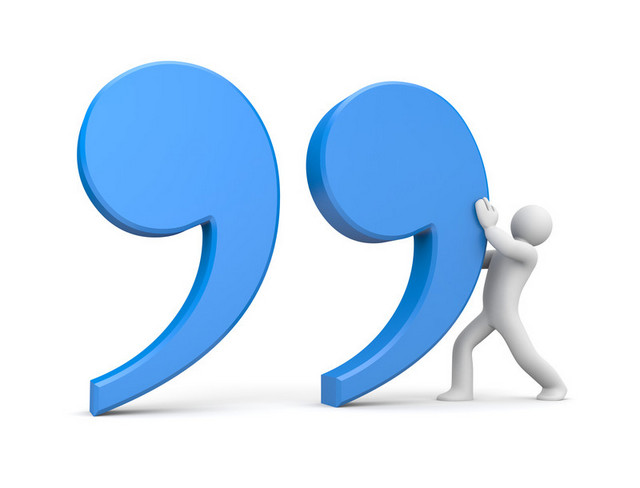Contents:
- Conciseness
- Contractions
- Punctuation
- Information dumping in dialogue: “As you know, Bob…”
- Info-dumping monologues
This is the fourth article in my series on how to write effective dialogue in fiction. In the first, I wrote about foreign accents and dialects. The second covered the essentials: realism through artifice, the four purposes of dialogue, and creating distinction between characters. You can read that post here. In the third, I discussed the balance of dialogue to narrative, dialogue in your opening pages, dialogue tags, action tags, Tom Swifty adverbs, and gave you some extra dialogue tips. You can read that post here. Today, after looking the broader issue of conciseness, I’ll focus on more mechanics of dialogue—contractions and punctuation—and then I’ll discuss information dumping.
1. Conciseness – cut the coffee orders

Have you been sitting in Starbucks, as I suggested in my first post on dialogue, working on perfecting your characters’ dialogue by eavesdropping on people to learn what natural discourse sounds like? It’s anything but concise. That’s why written dialogue is artificial, not a transcript of what you hear in real life. One of the three C’s of editing and writing is conciseness. (The other two are clarity and consistency.) In particular, the rule of conciseness needs to be applied to dialogue writing. Less is more. Enter the conversation late, and exit it early. Do this by eliminating greetings, goodbyes, social pleasantries, and filler chat—the reader’s mind will fill these in. Write only the essentials—the meat of the conversation.
Do you have anything like the following in your story? “Hi George. How are you?” “Hi Geena. I’m fine thanks.” “That’s nice. Well, see you later.” If you do, axe them all! There’s no room for this type of banal exchange in dialogue. For example, a scene with a tantalizing, powerful, cliff-hanger line of dialogue like this: “Turn around, you jerk, and get out of my house right now, or I’ll call your wife—and the police!” would be weakened by the other person saying, “Okay, goodbye.”
“I’ll take a double double, please.”
A manuscript I worked on a few years ago had a protagonist with a penchant for stopping at drive-through fast-food outlets whenever she went out. Not only did this in itself become tedious because it had nothing to do with the plot, but each time she visited a drive-through, her order was written out in dialogue in minute detail, similar to this:
“Hi,” Geena said.
“Hi. What will you have today?” the server asked.
“I’ll have a mini-burger and fries, please.”
“Did you want ketchup and salt with that?”
“No thanks,” Geena said, “but I’ll take a medium coffee too.”
“Cream and sugar?”
“Double double.”
“Okay,” the server said. “That’ll be five dollars and sixty-nine cents, please. Drive ahead.”
“Okay, thanks. Have a great day.”
“You too.”
Oh dear. You can imagine how much cutting I was doing in that editing project. It’s easy to see that this conversation is dull, flat, and contributes absolutely nothing to create tension, move the plot forward, or build character. If mentioned at all, this type of thing should be summed up in the narrative in just a few words: She grabbed a hamburger and coffee on her way to the meeting with Jason at the morgue. Ideally, it should all be cut because it likely has nothing to do with the plot, although it might be argued that frequent trips to the drive-through do show some aspect of the character’s personality.
2. Contractions
A contraction, you may recall from your school days, is a shortening or contracting of a word or group of words to one word, with an apostrophe replacing the missing letters. In most modern fiction dialogue, unless a person is speaking emphatically, they’ll usually say, “I won’t/can’t/didn’t do my homework,” not “I will not/cannot/did not do my homework.” So, if your characters speak standard modern English as opposed to nonstandard (for more on this, see my blog post on how to write foreign accents and dialects), it’s important that you use contractions in their speech to emulate the way people speak naturally, in real life.
A recent manuscript I edited was rife with stilted dialogue because few contractions were used. Scenes with dialogue went something like this:
“We should not go in there, Genie. I cannot see anything good happening.”
“It is not your decision. I am going even though you do not want me to. She will be happy to see me, I am sure.”
“I do not think so. She does not accept our family. She will be angry.”
“I do not care. I will kill you if you try to stop me.”
Now read the exchange with contractions used. I’m sure you’ll see how it flows much more naturally:
“We shouldn’t go in there, Genie. I can’t see anything good happening.”
“It’s not your decision. I’m going even though you don’t want me to. She’ll be happy to see me, I’m sure.”
“I don’t think so. She doesn’t accept our family. She’ll be angry.”
“I don’t care. I’ll kill you if you try to stop me.”
When using contractions, keep the historical period, education level, and geographic location of your characters in mind. People from the 19th century, for example, tended to speak more formally than we do nowadays, so fewer contractions are needed. And mix it up a bit—contractions need not be consistently used. Context and word choice will dictate a contraction or the long form should be used. Read your dialogue aloud and listen for authenticity in your use of contractions.
3. Punctuation

Punctuation for dialogue follows some standard conventions. This includes surrounding dialogue with double quotation marks if you’re in North America, or single quotation marks if you’re in the United Kingdom. If you veer from these conventions, you risk having readers think they’re seeing mistakes or jarring them out of the fictional world you’ve created. Recently, I’ve edited authors who have tried innovative treatments for dialogue, such as:
- Using no quotation marks at all,
- Using guillemets («angle brackets») to surround internal dialogue (thoughts) between two characters, and
- Starting each piece of new dialogue with a long dash instead of quotation marks.
While these unconventional devices may be innovative and creative, they also run the risk of seeming a bit affected and gimmicky. Perhaps the biggest reason to stick with conventional punctuation is that it’s almost invisible to readers because they’re so used to seeing it. The eye glosses over the quotation marks as if they’re not there, and the flow of the dialogue—the words and their meaning—isn’t impeded. The reader isn’t jarred out of the story the way she might be while the mind pauses—even for a split second—to process the unusual punctuation or lack of it. I’m not suggesting that you not be innovative; just be aware of the risks involved in straying outside the norm when it comes to dialogue punctuation.
More conventions for punctuating dialogue
- Begin a new line for each new speaker; each new line should have a standard indent.
- A period should not precede a dialogue tag. Only commas, exclamation marks, and question marks are allowed to precede a dialogue tag. The tag is considered a part of the sentence. But use a period (or exclamation mark or question mark) if the dialogue is followed by an action tag. And please note that in the case of dialogue that uses an exclamation mark or question mark before the dialogue tag, no additional comma is needed, although the tag’s verb remains lowercased.
→ Incorrect: “I’m right most of the time, that’s all.” said Marion.
→ Correct: “I’m right most of the time, that’s all,” said Marion.
→ Correct: “I’m right most of the time!” said Marion.
→ Incorrect: “I’m right most of the time!,” said Marion.
→ Incorrect: “I’m right most of the time!” Said Marion.
→ Correct: “Don’t you know I’m right most of the time?” said Marion.
→ Incorrect: “I’m right most of the time, that’s all,” Marion waved him off.
→ Correct: “I’m right most of the time, that’s all.” Marion waved him off.
- Keep final punctuation inside the quotation marks. Examples: “This isn’t the right door,” said Byron. “Yes, it is!” Julia exclaimed. “Why do you always think you’re right?” Byron said, exasperated. Julia twisted the knob to no avail. She sighed. “I’m right when I’m right, that’s all.”
- Quotes within quotes. If a word or phrase within the dialogue needs to be in quotation marks, use single quotation marks for those if you’re in North America and double quotation marks if you’re in the UK. These are sometimes called quotes within quotes, and they might look like this (in NA English), where Marion is using the word “celebration” out of context: “I’ve got to go to that awful ‘celebration,’” Marion said, dreading the retirement lunch of her career nemesis.
- Use ellipses for trailing-off dialogue. If a character’s dialogue is truly trailing off, or if she pauses during her speech, a three-dot ellipsis should be used to indicate this. “I’ve got to meet that horrible…person,” Marion added. “I don’t know if I can do it…” To create this, simply type three dots in a row, and MS Word will automatically turn them into a single symbol, called a glyph. It’s a style choice whether you want to leave a space before and after the glyph or not. Be consistent with your choice.
- Use em dashes for interruptions. If dialogue is interrupted sharply, a long dash (called an em dash) is used, like this: “I don’t know if—” Marion began. “Shut up!” Julia shouted. “I don’t want to hear any more about your troubles!” Em dashes can have spaces on either side but they generally look better closed up. They can also be used as a softer form of colon to point to something coming up—like this.
- Use em dashes for stuttering or stumbling speech, like this: “I—I—don’t know if—if I said the right thing,” mumbled Marion.
- Use hyphens for stuttered letters within a word, like this: “C-c-cut it out, M-M-Mike.”
- Avoid using colons and semicolons in dialogue for the most part. This is my opinion only; I find they look too formal for dialogue. People don’t speak in colons and semicolons; save them for your narrative, where the writing is more formal. The em dash is a better choice for dialogue because it’s softer.
- Closing quotation marks. Sometimes your character may have a long monologue that needs to be separated into multiple paragraphs (but see #5, below). When starting a second paragraph of dialogue by the same speaker without a tag to break things up, do not use a closing quotation mark at the end of the previous paragraph, but do use an opening quotation mark at the beginning of the second paragraph (and third, etc.). Always end the last paragraph with a closing quotation mark.
4. Information dumping in dialogue: “As you know, Bob…”
Information dumping occurs when essential information (exposition) is not interspersed with the narrative, but is dumped in big chunks, resulting in an especially blatant form of telling (as opposed to showing). Any information you need to convey to your reader should be doled out in little bits, interwoven organically through the story.
This is especially true in dialogue. An info dump in dialogue tries to sneak information to the reader by having one character tell another character something they both already know, and it always sounds contrived and artificial. It’s also condescending to readers; while they may not know it’s called an information dump, they’ll know instinctively that it’s not natural. For this reason it’s sometimes called an “idiot lecture,” and your reader should never be treated like an idiot. It is also known as an “As you know, Bob…” (AYKB), and the classic situation usually goes something like this:
→ “As you know, Bob,” said Bert, “our parents died in a car accident back in 2004…”
Of course Bob knows when and how his parents died; to have his sibling tell him this is disingenuous. You may laugh, but I’ve seen this situation often enough in my editing work. Use other ways to “dump” information, by telling it to the reader more organically. For example, you might have Bert thinking, I wonder if I should bring up our parents’ accident—again. It’s been ten years, but Bob’s still a wreck whenever it comes up. In this way, you’re still giving the reader the information she needs, but this is a more natural way of conveying it.

Another form of info-dumping idiot lecture occurs when the antagonist or villain, near the end of the story, thinking he’s finally captured the hero, suddenly discloses his entire evilly masterminded plan to said hero by way of a confession. This usually serves no other purpose than for the author to conveniently wrap up loose ends. Good writers avoid this type of info dump, working details in naturally, giving hints, or assuming readers are smart enough to figure things out for themselves.
Yet another form of info dumping occurs near the beginning of a story when characters refer to each other too often by name, just to familiarize readers with their names. “Bob, my wife Julia is going to join us soon.” “Great, Bert. I’ll have to tease her about that last tennis game you two played with me and my girlfriend Marion.” Clearly, these two sets of characters know one another, but their names and relationships are given out solely for the reader’s benefit. Again, it’s artificial, and there are much more natural ways of giving readers this information, even if it takes a page or so to get there.
5. Info-dumping monologues
In general, avoid long monologues in your fiction dialogue. They almost always consist of info dumping—one character trying to feed information to another for the benefit of the reader. The problem is, there’s rarely a benefit for the reader—unless maybe you love to read Shakespeare. Long soliloquies in modern dialogue stop the plot’s action and yank the reader right out of the fictional world you’ve worked so hard to create. It’s called dialogue for a reason (dia means “two,” mono means “one,” and logue comes from “logos,” which means “word”)—it’s spoken interaction between at least two people.
There are several ways to avoid info-dumping monologues in your dialogue. First, keep in mind that readers need only the information that is essential to the plot at any given moment. If you want to let your readers know all about your passion for a subject like classical music, for example, save it for another book—nonfiction, preferably. I recently tried to read some well-intentioned fiction in which the author apparently wished to convey every minute scrap of knowledge in her brain about classical music not only through her plot but through her characters’ dialogue. I couldn’t get beyond forty pages, and was sorry I wasted my money—even though I’m enthusiastic about classical music. When I’m reading fiction, I want to read a compelling story, not a treatise on the violin works of Paganini.
Don’t get me wrong—not all information dumping is inherently evil. Sometimes—in fantasy and sci-fi in particular—the reader needs more information to become immersed in the world you’ve created. But they rarely need all the information all at once. Show your information sometimes; make it carry part of the story. Rather than dumping it in dialogue, integrate your more basic information into your narrative as often as you can. Save dialogue for only the most dramatic bits.
And if you must write a long speech because it’s essential to the plot’s development, try not to write more than a few lines in a row. Break up the soliloquy by using dialogue tags, action tags (action beats), gestures, facial expressions, and reactions—both verbal and physical—from both the speaker and other characters to punctuate a long speech.
(For more on dialogue tags and beats, see my previous article on dialogue here. For more about information dumping, see my article Why “show, don’t tell” is the big myth of fiction writing. Also see Part I and II of my series on dialogue here and here.)
In summary
In this post, I’ve covered almost all the remaining elements of dialogue in fiction: conciseness, contractions, punctuation, and information dumping. In my next and last post on dialogue, I’ll delve into the intricacies of writing internal monologue. It’s a huge topic!
And in the meantime, please let me know whether I’ve I missed anything you’d like me to address regarding how to write dialogue in fiction. I’m happy to collect ideas and add them to my next post.

9 Responses
(don’t know if my first letter went through)…I treasure all your information Arlene and want to put it to good use since you are taking your valuable time to give it to us. I use both forms of dialogue in my book. The men are less informal and use “short-cuts,” but the female uses a more formal approach….Since she is from 1875, and well educated, I thought her dialogue should reflect her education…Am I correct in this assumption? June
You are absolutely correct, June. Dialogue in historical fiction would naturally be more formal, so fewer contractions would be used. You’re right to take into account her background and education level, too, in determining the level of formality you apply to her dialogue. In fact, I think I’ll add those items to this blog post. Thanks so much for your comment, and making me think of something I hadn’t when writing about contractions. Much appreciated!
I was so glad to get your reply and read your answer. Now I will not have to change the entire book regarding dialogue. It’s always nice to know you are on the right track, especially from a professional like you…You made my day. Thank you very much…June
I so enjoy all that you offer on the important subtleties of dialogue. Addressing one point, reading aloud definitely helps to discover whether it calls attention to itself as dialogue. As an editor with a film degree, I’ve found many similarities between what you’ve continued to describe and the teachings of the industry’s most respected screenwriters. In Story: Substance, Structure, Style, and The Principles of Screenwriting, Robert McKee discusses subjects such as “long speeches” being “antithetical with the aesthetics of cinema.” He suggests watching “a second hand crawl around the face of a clock for a full sixty seconds…” The eye of the reader, as well as the viewer, can get bored easily, and once it leaves the screen, or the page, you’ve lost your audience.” In keeping with your advice, he advises that writers “obey the Law of Diminishing Returns. The more dialogue you write, the less effect dialogue has.” I realize there are always exceptions, but this seems to be a good launching point. Looking forward to your next segment.
All your comments are very astute, Irene. Thanks for taking the time to reference them, too. You’re entirely right: there are many cinematic comparisons with dialogue in written fiction. I don’t have your film background, but I learned exactly that through much Googling and research for all my blog posts on dialogue, in which every other article I found on dialogue writing seemed to make one comparison or another to film or television. I especially found that with the topic of information dumping. Apparently the “As you know, Bob” info dump trick is rife in film and TV!
Thank you again for a set of very detailed and extremely useful blogs on dialogue. The level of detail is amazing – things like punctuation, the use of dialogue in the opening pages, the dialogue v narrative ratio, to name but few. There are many books on the market on dialogue but not many give such down to earth advice. Since reading your blogs I’ve become much more aware of how I write on a daily basis. Even here – should I have used caps for ‘earth’ or not, for example. Great job, thank you.
Thanks so much for your comment, Gabriela. I’m so pleased that you’re finding my posts helpful. A colleague gave me the idea that I should gather all my posts on fiction — or maybe just the ones on dialogue — and put them into a free ebook, and I’m now thinking of doing that so they’re all together in one place for readers. And no, no cap for “earth” in that case. “Earth” is only capped when it refers specifically to the planet Earth, and even then, capping or lowercasing it is not a rule but a style choice you make that should be consistent throughout your story, whatever you decide.
Hi, Arlene, I just want to say thanks for sharing valuable content. It can be very beneficial to those who need it.
Thanks for commenting, Derrick. The benefits certainly work both ways. If an author understand these concepts before sending me their manuscript to edit, the work goes faster and more easily for me. Authors save money and I save time — win-win!